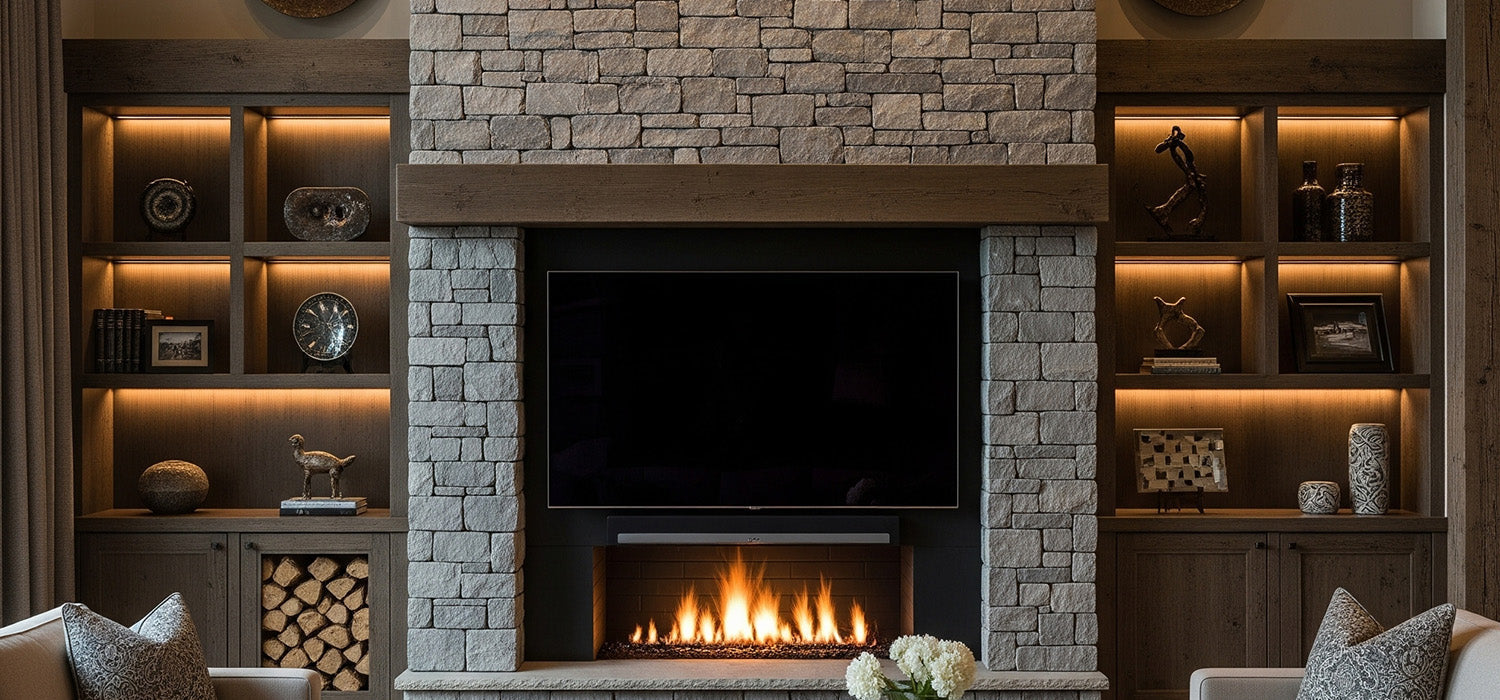
MDF vs Plasterboard for Media Walls: Which Should You Choose?
Building a media wall and stuck between MDF and plasterboard? Quick answer: MDF is sturdier and stylish, while plasterboard is cheaper and easier. But wait—there’s more to it than just cost and appearance. From fire safety (yes, think Media Wall Fire) to soundproofing secrets and shelving strength, we break it all down. This guide will help you confidently pick the right material to suit your space, style, and needs—without second-guessing halfway through the project.
Understanding the Materials
Medium Density Fibreboard (MDF)
Composition and Manufacturing
MDF, or Medium Density Fibreboard, is made from wood fibres, wax, and resin, all pressed together under high heat. It’s basically engineered wood—but more uniform, denser, and a whole lot smoother. Builders love it for its reliable strength and finish, especially when working on custom installations like media walls.
Key Characteristics: Smoothness, Density, Ease of Machining
MDF is wonderfully smooth—so smooth, in fact, that you don’t need plastering. It’s dense all the way through, which means screws grip nicely and shelves won’t sag. Carving out speaker recesses or cable routes? MDF handles detail beautifully. Plus, there’s no pesky grain to work around.
Plasterboard (Drywall/Gypsum Board)
Composition and Manufacturing
Plasterboard (or drywall, if you’ve watched too many American renovation shows) is made from a gypsum core sandwiched between layers of heavy-duty paper. It comes in large, flat sheets and is a staple in most home builds. Light, easy to handle, and quick to fit—it's the go-to for straightforward walling jobs.
Key Characteristics: Fire Resistance, Ease of Cutting, Plastering Required
Standard plasterboard already offers good fire resistance, and the fire-rated stuff is even better—ideal around electric fires or heaters. It’s lightweight and can be cut with a simple knife. But—there’s a catch. You’ll almost always need to skim or plaster over it to get that polished finish.
Direct Comparison: MDF for Media Walls
Advantages of MDF
Extremely Smooth Finish (Excellent for Painting)
MDF’s factory-smooth surface is a dream if you’re planning a painted finish. Just prime and paint—no filler, no skim coat, no faff.
No Plastering Required (Faster Finish)
Because of that smooth surface, you can skip the messy plastering stage entirely. That’s one less trade to coordinate and faster results.
Stronger for Shelving and Fixings (Less Sagging)
Putting up a soundbar? Displaying books or décor? MDF won’t bow like plasterboard. It’s sturdy enough to hold its shape under weight, making it a smart pick for integrated shelving.
Easier to Cut Intricate Shapes and Recesses
MDF behaves brilliantly when cut, so whether you're carving out a niche for your console or hiding cables, the finish is clean and precise.
Consistency in Density
No soft patches, no surprises. MDF is the same throughout, which means you’ll get consistent results across the entire build.
Disadvantages of MDF
Heavier than Plasterboard
MDF’s strength comes with weight. It’s noticeably heavier to lift and fix in place—so you’ll want an extra pair of hands (or a decent joiner).
Susceptible to Water Damage (Unless Moisture-Resistant MDF)
Standard MDF doesn’t like moisture. If you’re working near fireplaces or damp areas, always opt for the moisture-resistant variety—look for MR-MDF.
Generates Fine Dust When Cut (Requires PPE)
Cutting MDF kicks up very fine dust. You’ll need proper extraction or at the very least a dust mask and goggles—especially if you’re doing it indoors.
Can be More Expensive
Between higher material costs and specialist labour, MDF can be pricier than plasterboard. But the finish and strength often justify the spend.
Direct Comparison: Plasterboard for Media Walls
Advantages of Plasterboard
Fire Resistance (Especially Fire-Rated Plasterboard)
Plasterboard offers solid fire protection—and fire-rated boards are often required by building regulations when you’ve got a media wall fire setup.
Lighter and Easier to Handle
It’s light, simple to cut, and quick to hang. A decent DIYer could handle plasterboard with minimal tools and effort.
Good Acoustic Properties (Sound Dampening)
It may not be as dense as MDF, but plasterboard still helps absorb sound—especially when paired with insulation behind.
Readily Available and Cost-Effective
Available at virtually any builders’ merchant, plasterboard is cheap and cheerful. Great if you’re watching your budget.
Creates a Traditional Plastered Look
Once skimmed and painted, plasterboard looks like a continuation of your existing walls—ideal if you want your media wall to blend in.
Disadvantages of Plasterboard
Requires Skimming/Plastering for a Smooth Finish
You’ll need a plasterer to get that silky-smooth finish. It adds time, cost, and coordination to the project.
More Fragile and Prone to Damage (Dent/Holes)
It’s easy to knock, chip, or dent plasterboard—especially during installation or decorating.
Less Structural Strength for Direct Fixings (Requires Reinforcement)
TV brackets or shelves? You’ll need to reinforce with timber behind or use special fixings. Plasterboard alone can’t take the load.
Messier Installation Process
Wet plaster, sanding dust, and touch-ups—it’s not the tidiest option. If you’re mid-renovation, prepare for a bit of chaos.
When to Choose MDF
Seeking a Seamless, Painted Finish without Plastering
If you’re after a sleek, modern look and want to skip the plasterer, MDF is ideal. You’ll get a flawless finish straight off the roller.
Designing Integrated Shelves or Cabinets
Planning on floating shelves, speaker boxes, or decorative storage? MDF handles weight and wear better.
When Precision Cutting and Detailing are Important
MDF shines when detail matters. From LED recesses to curved edges, it allows more creativity with fewer compromises.
When to Choose Plasterboard
Prioritising Fire Safety (Around Fireplaces)
If your media wall is near a fireplace, plasterboard (especially the fire-rated kind) is a safer, regulation-friendly bet.
Desire for a Traditional Plastered Look
Want your media wall to blend in with the rest of your home? Plasterboard is your friend.
Budget is a Primary Concern
If cost is king, plasterboard wins. It’s cheaper to buy and install—just factor in the extra labour for plastering.
Less Focus on Integrated Shelving or Heavy Loads
If your media wall is purely decorative—with no shelving or cabinets—plasterboard will more than do the job.
Can You Use Both? (Hybrid Approach)
MDF for Cabinets/Shelves, Plasterboard for Surrounding Walls
This is where things get clever. Use MDF where strength is essential—around shelving, niches, and mounting points—and plasterboard for the rest. It’s a smart way to balance budget, function, and finish.
Conclusion: Making the Right Material Choice for Your Media Wall
There’s no single “best” material for media walls—just the right one for your home, your style, and your budget.
Choose MDF for strength, detail, and a flawless painted finish. Go with plasterboard for a cost-effective build, traditional look, and better fire safety. Or do what the pros do and mix both—each material doing what it does best.
At the end of the day, it’s all about creating a space that works for you—stylish, safe, and built to last.
Other content we think you'll love
- Can I Build a Media Wall Myself? A DIY Guide for UK Homes
- How to Build a Stylish Media Wall with TV & Fireplace
- Can You Build a Media Wall Over a Radiator? A Stylish Guide
- Can You Build a Media Wall on Carpet? Tips for a Stable Setup
- Can You Build a Media Wall Around a Fireplace? A Cosy & Stylish Upgrade
- How to Build a Media Wall on a Chimney Breast (UK Guide)
- Can You Build a Media Wall in a Council House? A Practical Guide
- The Ultimate Guide to Buying a Pre-Made Media Wall in the UK
- How to Attach Plasterboard to a Media Wall: A Step-by-Step Guide
- How Deep Should Your Media Wall Be? A Guide to Perfect Fit & Function
- Are Media Wall Fires Safe? What Every UK Homeowner Should Know
- Can You Build a Media Wall Without Plastering?
- How is a Media Wall Built? A Step-by-Step DIY Guide
- What Are the Disadvantages of Media Walls? A Cautionary Guide
- What is a Media Wall? The Ultimate Living Room Glow-Up

